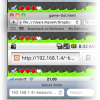Show me the pixels.
Akihabara is composed of a number of libraries that use HTML5 canvas tag and some standard hooks. Gamebox module is complete and compact enough for making games: it allows multiple grouped objects moving simultaneously, it helps with collisions, rendering and moving objects. It provides monospaced pixel-fonts rendering too. It handles keyboard, double buffering and FSEs. Games can also store some kind of data easily using cookies and load/unload resources at start or while the game is running. Audio is provided via the HTML5 audio tag and allow volume/muting/seeking/tracking of multiple audio files. Gamecycle module provides a complete generic game cycle: intro, menus, crossfading between stages/lifes, gameover and ending. You can use the same game cycle for many games and implement only the main game. Toys module provides lots lots of common routines during the game developing: from effects for screen titles to HUD handling to platform/SHMUP/RPG oriented routines, like jumping characters, Z-Indexed objects, bullets, sparks, staff rolls, bonus screens, dialogues, audio crossfading etc. Help module provides some Javascript-specific functions, such object copying, randomizing functions, string/array handlers and the akihabaraInit function, that automatically sets a comfortable preset of configurations: 25fps, landscape 320×240 resolution with double-sized display for non-mobile devices, dynamic frameskip. This default behaviour can be changed with its arguments. Also setup different settings depending on the used browser. Tool module provides simple developing tools. Actually there is only a cel-composer: it can compose an image stacking a set of frames for animating objects, applying a number of filters to each frame. Trigo module provides some math stuff for moving objects in a direction or following a round path. Iphopad / Iphofretboard module provides a touchpad/fretboard for touch-based device (for now, Android and iDevices). (via Akihabara)
